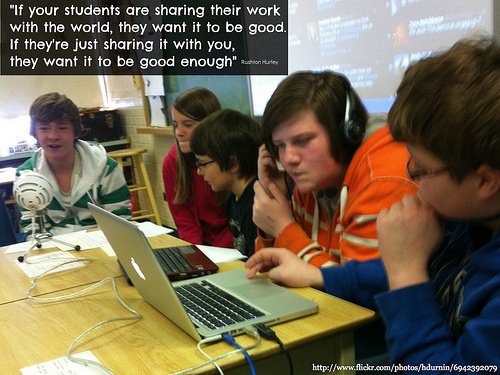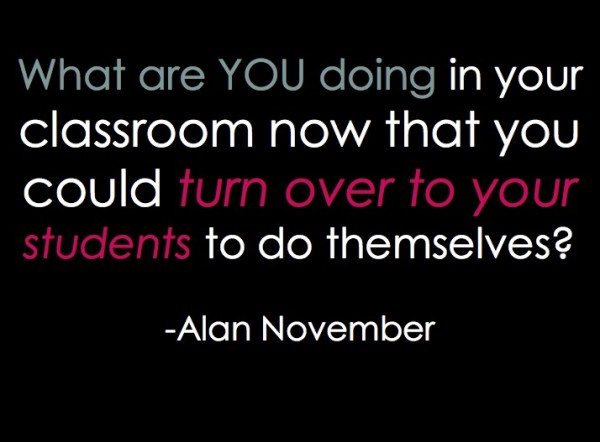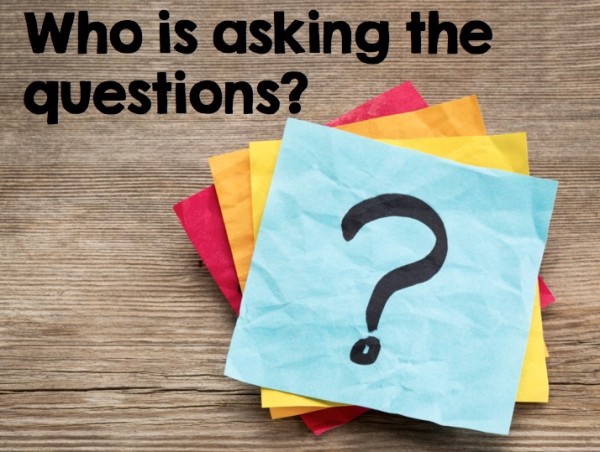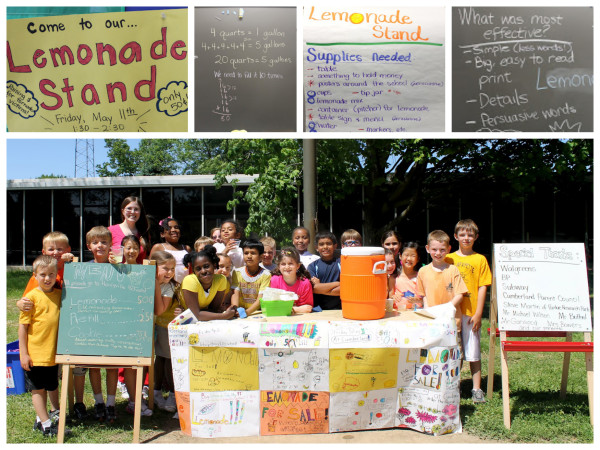Are you working harder than your students? Learn practical strategies for making the learning really matter to kids so they’re self-motivated in the classroom. You’ll discover how to inspire kids to give as much energy and effort in the classroom as you do!
This post is based on the latest episode of my weekly podcast, Angela Watson’s Truth for Teachers. A podcast is essentially a talk radio show that you can listen to online or download and take with you wherever you go. I release a new episode each Sunday and feature it here on the blog to help you get energized and motivated for the week ahead. Learn more about the podcast, view blog posts for all past episodes, or subscribe in iTunes to get new episodes right away.
Want to listen instead of read?
Listen to episode 5 below,
or subscribe in your podcast app.
We talked in the last episode about the importance of creating a reciprocal energy flow–gaining energy from kids instead of letting them drain you. This week’s episode is really a continuation of that topic, because if you want to get anything back from your kids, they’ve got to have some ownership over their learning.
Tell me if this is a familiar scene in your classroom: you ask a question, and the same 4 kids raise their hands every time. The kids aren’t listening to your directions and have no idea what to do for a task so you keep repeating yourself. You’re constantly trying to convince them that a topic is exciting and that the task is going to be fun, and they’re dragging their heels and only completing the work if you’re standing over them, praising, encouraging, threatening, yelling, bribing, or whatever trick you pull out of your bag that day.
If you can relate to that scenario, there’s nothing to be embarrassed about. Every teacher has been there, and most of us feel like that on a regular basis. It’s normal. But it doesn’t have to be that way! The more ownership of the learning you hand over to students, the more engagement you’re going to have.

So how do you do that? First and foremost, you’ve got to make the learning matter. If the tasks you’re giving your students are irrelevant, you’re going to have to work twice as hard to get kids to participate, and you’re not going to get any energy back from them.
Kids need to have a meaningful purpose for their work just like we as teachers do! They need to believe that the tasks they do make a difference beyond the four walls of the classroom. Student engagement comes naturally when kids identify a need or problem in the world and create ways to use skills you’ve taught them to solve those problems.
My friend Jenny teaches 3rd grade and blogs about it at Luckeyfrog’s Lily Pad. Last spring, her class completed an amazing project that I think is the perfect example of turning the learning over to students. They had already finished their standardized testing for the year and had a little bit more flexibility in the curriculum and scheduling. So, Jenny helped them identify a need in their community: they wanted to help people in a nearby town who were affected by tornados.
One of the kids got the idea to sell lemonade. Listen to all the skills these kids practiced: They estimated their costs, raised capital, asked the PTA to become an investor, created a Google form to organize parent volunteers and a doc to create a schedule, made persuasive advertisements, did a science experiment to find the right recipe, counted the money they made, and wrote thank you notes.
These students’ learning resulted in changing outcomes: their hard work wasn’t just to get an A on a paper—their work mattered to other people, to those victims of the tornado.Though it probably won’t be possible to do something like that for every lesson you teach, I encourage you to use stories like these as inspiration and make your students’ learning matter in any way you can.

Here’s the thing. If your students are sharing their work with the world, they want it to be good. If they’re just sharing it with you, they want it to be good enough.
Most kids aren’t excited about writing a paragraph when the only person who’s going to read it is the teacher (and he’s just going to mark it up and explain everything that’s wrong with it.) Try to publish kids’ work as much as possible, even if it’s just on a school website or class blog. Look for ways to give kids an authentic audience that they care about and will work hard to impress.
The learning matters more when you get kids connected with the outside world. Have your kids participate in a project started by my dear friend Pernille Ripp. It’s called the Global Read Aloud. Students all around the world read the same book and then discuss it with other classes via Skype.
Or, here’s another idea. You would be amazed how many children’s book authors are willing to do a Google Hangout with classes. Imagine how motivated some of your students would be to read a book if they knew they’d get to ask questions from the author afterward!
You’ll notice in all of these examples, not only does the learning matter, but the responsibilityfor the learning has in large part been placed in the hands of students. That’s a really important strategy for gaining energy from kids.
Get kids actively involved in their learning so they’re doing just as much work–or even more–than you are. When students take charge of the learning process, they are able to channel their excess energy into pursuits that matter.
As their teacher, you become re-energized from watching the learning process in action and interacting with kids who are enthusiastic about their work. The flow of energy in the classroom becomes reciprocal as you motivate them, and they in turn motivate you.
So how can you get started with empowering kids to take more ownership of their learning? The brilliant Alan November once posed a question that I think is a fantastic starting point. He said, “What are you doing in your classroom now that you could turn over to your students to do themselves?”

Can you do more student-directed projects? Can you involve students in the assessment process, giving them a chance to create rubrics and grading criteria and score themselves? Can you use technology to give students more choice in how they demonstrate knowledge?
Turning the learning over to students is probably the best way I’ve seen to increase student engagement. You see, engagement is not the same thing as compliance. Some of our “best” students are simply people pleasers. They sit up straight and fold their hands on their desks because they’re doing what we tell them to do, not because they’re truly invested in their own learning.
There’s also a difference between being busy and being truly engaged. Sometimes kids know how to go through the motions without really learning, or are hard at work on a task that won’t produce any real gains.
Here’s an easy way to get insight as to who has ownership of the learning. When kids are truly taking ownership, they will be asking questions which drive learning. If the teacher is doing all the questioning and the students are just answering, it’s possible the kids are being busy or compliant but are not truly engaged. The goal is to get kids asking why, how, what happens if, and couldn’t we. When they are posing questions that matter to them and then pursuing the answers, you can be sure they are thinking deeply about the topic and are invested in their own learning.

I go into a lot more depth about empowering students to take ownership of their learning in my upcoming book that I plan to release this spring. It’s called Unshakeable: 20 Ways to Enjoy Teaching Every Day…No Matter What. You can follow the link to learn more about Unshakeable, and sign up to be notified by email when it’s available and get free sample chapters in advance before anyone else.
I like to end each podcast episode with with motivational quote for the week ahead that I call the Takeaway Truth. Here’s the takeaway truth I want you to remember this week:
The person doing the most talking is the person doing the most learning. Click To TweetGive kids a chance to talk, to construct their own knowledge, to give input as to what and how they learn, and you’ll find that their engagement levels shoot way up. In return, you’ll experience a new sense of motivation and energy as your students are giving just as much as they’re getting.
Next week: How to stop being overly critical of yourself as a teacher
![]() See blog posts/transcripts for all episodes
See blog posts/transcripts for all episodes
The Truth for Teachers Podcast
Our weekly audio podcast is one of the top K-12 broadcasts in the world, featuring our writers collective and tons of practical, energizing ideas. Support our work by subscribing in your favorite podcast app–everything is free!
Explore all podcast episodes
Angela Watson
Founder and Writer
Sign up to get new Truth for Teachers articles in your inbox
Discussion
Leave a Reply
OR

Join our
community
of educators
If you are a teacher who is interested in contributing to the Truth for Teachers website, please click here for more information.




















Hi Angela,
I just recently started working with an organization dedicated to improving education through student engagement, achievement, and accountability.
One of the main themes that we coach, over and over again, in the district leaders that we work with and the teachers that we train is student ownership. I love that your blog and podcast reinforces that. I just started listening, and I am going to pass your podcast on to our partners as a tool.
Education is a new industry for me. I had no idea what to expect, and I was baffled and excited to learn what it really takes to shape the minds of our future leaders. It is so refreshing to connect with people who are dedicated to making a difference, regardless of the hard work it takes. I hope to learn much more from listening to your podcast and reading your blog. Thank you for your dedication!
Mandy Volodymyrenko (or just Mandy)
I’m glad you reached out and introduced yourself, Mandy, and that the podcast has been a helpful resource!
Thank you Angela for a very insightful podcast! Now I just have to get my creative juices flowing to get the students to take ownership of their learning.